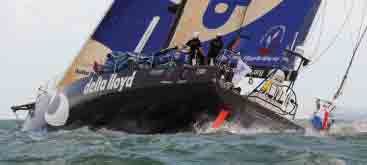
The crews have already taken a battering in the early part of this race and it is set to continue as the race takes on new levels of intensity and sailing at the extreme.
These boats are built for entirely different conditions but such is the course that the race committee have plotted.
The extreme conditions that these sailors and more importantly the boats, find themselves in would have adverse effects on the structure of the boats.
To explain it a little easier, these boats are designed to sail where the wind would coming over your shoulder hitting the side of your face and indeed the side of the sail, if you were facing towards the bow. Think of it as you would ideally like the wind to come from anything between 3, 4 and 5 o’clock if 12 noon is the bow of the boat straight in front of you.
The idea is that wind coming from this directing would give the boat the maximum amount of speed as it cut through the water.
The hulls, mast and structural rigging would be set up like that on these mammoth boats to harness this power and translate it into speeds of anything between 20, 30 and 40 knots. Optimum speed can be faster than a hi powered speedboat and if you are familiar with sailing at that speed, it’s pretty fast. These boats don’t have brakes don’t forget.
Anyway, the leg that the seven boats face into on the way to Qingdao will have the wind hitting the boats and sailors at 12 o’clock – the worst possible condition for both comfort and speed.
The sea state will be considerably worse than lumpy, where 10 metre swells would not be uncommon and are quite likely to be surpassed.
This will be a tough one and only the toughest strongest boats will last the course.
Hence the boats would be designed and built to skim the water as opposed to pound through it like a lump hammer.
The early stages has produced constant speeds but those are somewhat similar throughout the fleet and hence the bunching of the fleet where small margins separate the lead boat from the rear of the fleet.
The two Irish boats were jostling with the Spanish boat, Telefonica Black and one of the Swedish entries, Ericsson 3 before disaster hit Green Dragon when the broke the boat’s forestay. This comes as a major blow to Ian Walker and his crew as they are now forced to sail with a temporary rig in place and now having the choice of just one sail.
Delta Lloyd hit fourth position at one stage during the week where only two miles separated the leaders and Ger O’Rourke’s first generation entry. With a considerable amount of positional jostling, Delta Lloyd hit the way-point, a mark known as the South Rock Light that the yachts had to stay to the east of, in fourth just behind the leading bunch of Telefonica Black, Puma Ocean Racing and Telefonica Blue.
The yachts will continue their race north of Borneo, in very difficult conditions, before tacking and adjusting their route to Taiwan where a decision of going inside or outside the island faces all the crews.






